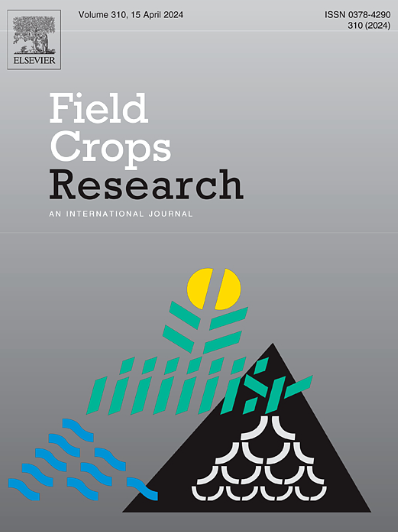Sugar kelp application for sustainable potato production in Prince Edward Island: Impacts on soil, greenhouse gas emissions, and yield
IF 5.6
1区 农林科学
Q1 AGRONOMY
引用次数: 0
Abstract
Context
Sugar kelp (SK) is a promising organic fertilizer with the potential to enhance crop yield, improve soil health, and reduce environmental impacts. However, its specific effects on soil quality, crop productivity, and particularly its role in climate change mitigation are still not well understood.
Objectives
This study evaluated the effects of SK, as seaweed-based organic fertilizer, and its combinations with IF on soil health, emissions of CO2 and N2O, as well as CH4 uptake, potato growth and yield during the 2023 and 2024 growing seasons in Prince Edward Island, Canada’s largest potato-producing province.
Methods
Field experiments were conducted over a two-year period (2023 and 2024). In 2023, treatments included: SK alone (2 tons ha-¹), IF alone (meeting the full nitrogen (N) requirement), SK + IF (50 %-50 % N), and control (no fertilizer). In 2024, treatments were: IF alone, SK + IF (full N), SK + IF (80 % N), and control. The study measured soil organic matter, pH, P2O5, K2O, Ca, Mg, Cu, Zn, S, Mn, Fe, Na, Al, and NO3-, along with the Normalized Difference Vegetation Index (NDVI), and potato yield. Soil emission of CO2 and N2O emissions, and soil CH4 uptake were also measured using the Li-COR trace gas analyzer.
Results
Soil pH, organic matter, calcium, magnesium, and cation exchange capacity remained stable across treatments. Trace elements such as copper, iron, and zinc also showed minimal variation. However, the SK application significantly increased soil sodium concentrations in both years (p < 0.05). In 2024, nitrate (NO₃⁻-N) levels were significantly higher in the IF treatments than in the control. Cumulative CO₂ emissions and CH₄ uptake did not differ significantly among treatments in either year. IF-only treatments showed the highest cumulative N₂O emissions, whereas treatments combining SK with reduced IF significantly lowered cumulative N₂O emissions to levels similar to the control. These reduced-emission treatments maintained NDVI values and potato yields comparable to those of the full IF treatments, both of which outperformed the control.
Conclusions
These results suggest that combining SK with reduced IF can sustain potato yields while significantly lowering N₂O emissions. These findings highlight the potential of SK in sustainable fertilizer strategies; however, further long-term research and economic analysis are necessary to evaluate its broader viability in agriculture.
糖海带在爱德华王子岛马铃薯可持续生产中的应用:对土壤、温室气体排放和产量的影响
糖海带(SK)是一种很有前途的有机肥,具有提高作物产量、改善土壤健康和减少环境影响的潜力。然而,它对土壤质量、作物生产力的具体影响,特别是它在减缓气候变化方面的作用,仍然没有得到很好的了解。本研究评估了以海藻为基础的有机肥SK及其与IF组合施用对2023年和2024年加拿大最大的马铃薯生产省爱德华王子岛土壤健康、CO2和N2O排放以及CH4吸收、马铃薯生长和产量的影响。方法采用野外实验法(2023年和2024年)。2023年的处理包括:单施SK(2吨ha- 1)、单施IF(满足全氮需求)、SK + IF(50 %-50 % N)和对照(不施肥)。在2024年,处理为:单独IF、SK + IF(全N)、SK + IF(80% % N)和对照。研究测量了土壤有机质、pH、P2O5、K2O、Ca、Mg、Cu、Zn、S、Mn、Fe、Na、Al和NO3-,以及归一化植被指数(NDVI)和马铃薯产量。利用Li-COR微量气体分析仪测量土壤CO2和N2O排放以及土壤CH4吸收。结果各处理土壤pH、有机质、钙、镁、阳离子交换量均保持稳定。微量元素如铜、铁和锌的变化也很小。施用SK显著提高了土壤钠浓度(p <; 0.05)。在2024年,硝酸盐(NO₃⁻-N)水平在IF处理中明显高于对照组。累积CO₂排放量和CH₄吸收在任何一年的处理之间没有显着差异。仅IF处理的累积N₂O排放量最高,而将SK与减少IF相结合的处理将累积N₂O排放量显著降低至与对照组相似的水平。这些减排处理维持了NDVI值和马铃薯产量,与全IF处理相当,两者的表现都优于对照。结论SK与IF结合施用可以在显著降低氮氧化物排放的同时维持马铃薯产量。这些发现突出了SK在可持续肥料战略中的潜力;然而,需要进一步的长期研究和经济分析来评估其在农业中的广泛可行性。
本文章由计算机程序翻译,如有差异,请以英文原文为准。
求助全文
约1分钟内获得全文
求助全文
来源期刊

Field Crops Research
农林科学-农艺学
CiteScore
9.60
自引率
12.10%
发文量
307
审稿时长
46 days
期刊介绍:
Field Crops Research is an international journal publishing scientific articles on:
√ experimental and modelling research at field, farm and landscape levels
on temperate and tropical crops and cropping systems,
with a focus on crop ecology and physiology, agronomy, and plant genetics and breeding.
 求助内容:
求助内容: 应助结果提醒方式:
应助结果提醒方式:


